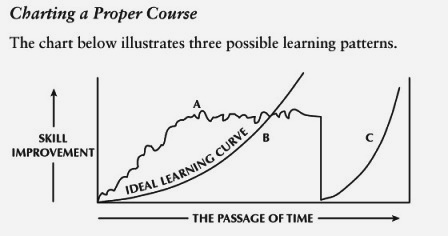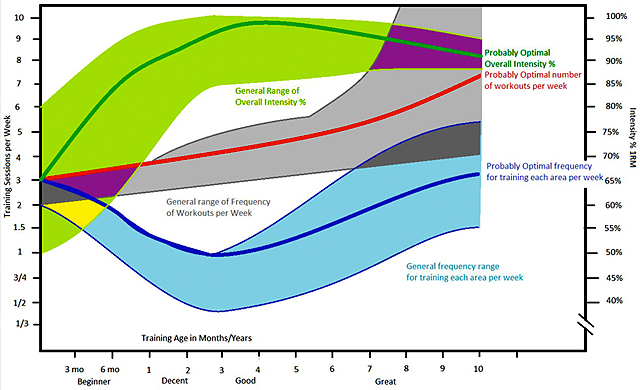How to Build Muscle Without Killing Yourself
 “Body mind masters take an easy, relaxed, progressive approach while working within the higher reaches of their comfort zone, thereby avoiding the burnout that accompanies a stressful approach to training.”
“Body mind masters take an easy, relaxed, progressive approach while working within the higher reaches of their comfort zone, thereby avoiding the burnout that accompanies a stressful approach to training.”
– Dan Millman
If there is one thing I wish I would have known when first starting out on my quest to attain a warrior’s physique… it would have been the secret of how to build muscle without killing yourself in the process! 😯
When you’re young you can get away with all types of brutal training and seemingly bounce back unscathed, yet in the end it will catch up with you.
Therefore, I don’t recommend pushing yourself to the extreme and killing yourself in the gym. Instead, I suggest a more enlightened approach.
“The point of training is to make yourself stronger, tougher and more attractive… to build the vitality and vigor to live a long, healthy, happy life… NOT turn yourself into a stiff, crippled mess who can barely walk up a flight of stairs in your thirties!”
You see a lot of so-called ‘hardcore’ guys and gals doing this type of extreme training, yet most of it is ego driven and self-defeating. Our culture even tends to perpetuate this type of “push yourself to the max” mentality to a fault… where only those with the best genetics can withstand such a stressful approach to building muscle in the long term.
You can get away with it for a while, yet eventually your joints and tendons start to break down and adversity strikes in the form of acute and chronic injuries.
After spending the past couple years working to correct my own injuries, tendonitis and muscle imbalances in my shoulders and hips, I’m speaking from experience here.

Don’t train like Wimpy either!
Yet, please don’t misunderstand me, I’m NOT encouraging anybody to train like a wimp or be a slacker.
It’s definitely important to train hard and give it your all… yet you must be smart about how you do this.
Because if you can’t continue to train… then kiss your muscle gains… GOODBYE! <<< Hey that rhymed! 😉
Besides, ultimately your workouts should be making you LOOK and FEEL better in the long run. They should improve your quality of life… not detract from it.
The irony here is that if you decide to follow a more ideal path to body mind mastery, you may actually achieve the coveted ‘hardcore’ status without killing yourself.
The Ideal Path to Body Mind Mastery
“When in a hurry… take the long, sure path.” – Sage Advice
In Dan Millman’s very insightful book “Body Mind Mastery”, he explains three possible learning curves for acquiring new athletic skills:

As he states it in the book, “Curve A represents the hasty, random, up and down learning curve of most athletes.”
Basically, these athletes are in a hurry to achieve their goals. They may make great improvements and gains at first, but they often have insufficient preparation and don’t spend the necessary time to develop a strong foundation upon which they can build in the future.
Therefore, as the skill requirements advance, weaknesses begin to emerge and their progress levels off. In some cases it can come to a grinding halt if they experience injuries, or reach a plateau.
“Curve B”, he says, “Is the path of the body mind master. At first they appear to improve very slowly. The path is initially difficult, with little to show. These athletes are working ‘below the waterline’, developing a hidden foundation. Gradually but surely, the learning curve begins to turn upward, until progress accelerates at a rapid, consistent, and almost effortless pace.”

“The journey is what brings us happiness not the destination.” – Dan Millman
You can see how the Curve B athlete starts off really slowly by learning the fundamentals of form, technique and proper movement patterns.
They gradually progress, allowing the body the time it needs to adapt and compensate to their training. Soon their progress begins to skyrocket and they surpass Curve A in both skills and ability.
Finally, Dan says that “Curve C is really the most important because it represents a second wind for most of us.”
This is great news because even if you didn’t start off on the ideal path (and let’s face it… very few of us do), you can start anew by getting back to the basics and relearning the fundamentals.
Even though this can be very frustrating at first, sometimes we need to take a few steps back in order to move forward and progress to the next level.
“If you are just learning how to build muscle then you have a wonderful possibility to start off on the right foot by integrating the proper mindset and training regimen from the beginning. I truly envy you and hope you will take full advantage of this opportunity.”
To help you to do so I’d like to share some hard-learned lessons and principles from my own experience that will get you on that “ideal learning curve” which Dan Millman discussed above. I also highly suggest reading his book for more detailed information on how to achieve Body Mind Mastery.
5 Crucial Principles on How to Build Muscle
I. Train for the Long Term

Frank Zane
In this day and age, everybody expects to be jacked in ONE MONTH!!! And there are plenty of marketing guys who will tell you that you can do so, but that shit ain’t the truth…
The Truth is that it’s probably going take longer than that. I know that sucks to hear but deep down I think you know this at heart!
Of course, some lucky people can and do make awesome transformations in short periods of time (if they do everything right).
Even so, it typically takes 3-12 months of disciplined training and nutrition to make a big transformation… NOT ONE MONTH!
“The stark reality though, is that it can take up to two years or longer to build your physique. In fact, many champions have trained diligently for ten years or more before reaching ‘peak perfection’.”
No one wants to hear that though… they want it RIGHT NOW! You have to escape the trap of instant gratification by training for the long term. If you do so, I think you will be pleasantly surprised at the progress you do make.
The years are going to pass by anyway… and when they do… are you going to be the person who burned out by trying to make a rapid transformation OR the one who took their time, enjoyed the journey and got the sweet taste of victory in the end?
II. Focus on the Fundamentals
When learning how to build muscle, realize that training is only one aspect of the equation. Training is simply the stimulus that tells your body that it needs to produce more muscle tissue. It’s the spark that lights the fire, so to speak.
“As important as proper training is to building muscle, your nutrition and lifestyle habits play an equal role in the results you’ll see from all of your hard work.”
 The Boss was definitely right, “You can’t start a fire without a spark.” Even so, without ample kindling, dry wood and fresh oxygen… you still might end up “dancing in the dark.”
The Boss was definitely right, “You can’t start a fire without a spark.” Even so, without ample kindling, dry wood and fresh oxygen… you still might end up “dancing in the dark.”
By focusing on the fundamentals in each part of the muscle building equation you create the necessary biological conditions that support hypertrophy and growth.
In your training focus on the following fundamentals:
- Learning the proper technique, movement patterns and posture
- Maintaining control of your body throughout the exercises
- Developing the mind-muscle connection through awareness and intention
- Using a full body contraction to create maximal tension
- Stopping the exercise prior to failure and a breakdown in form
- Make it your goal to get stronger slowly over time
For your nutrition fundamentals keep this in mind:
- Keep your diet 90% healthy organic whole foods with 10% treat foods
- Eat 70-120 grams of quality protein per day to build muscle
- Consume the bulk of your carbohydrates after training to stay lean
- Make sure to include essential fatty acids like Omega 3’s in your diet
- Eat tons of vegetables and leafy greens for micronutrients and fiber
- Drink plenty of water to keep the body and muscles hydrated
Embrace these fundamental lifestyle habits:
- Believe in yourself, choose to be happy and keep a positive outlook
- Take a calm, relaxed, and stress-free approach to life
- Get 8-9 hours of quality sleep each night
- Stretch, foam roll and do mobility exercises daily
- Spend at least ten minutes or more in meditation each day
- Minimize or eliminate the consumption of alcohol, drugs and other toxins
III. Take a Progressive Approach
 In order to build muscle and increase your strength you must take a progressive approach to your strength training.
In order to build muscle and increase your strength you must take a progressive approach to your strength training.
You may have heard of the bodybuilding principle of “progressive overload”, which is the gradual increase of stress placed upon the body during exercise training.
By progressively increasing the amount of reps you do, weight you lift, or difficulty of the exercise, you are overloading the musculoskeletal system.
This process stimulates the natural, adaptive processes of the body to have to cope with the new demands being placed on it.
Please take note and commit to memory the need for “gradual increase.”
“The body needs time to adapt. Not only do the muscles need to grow to handle the increased intensity, but your bones must become denser and your tendons and ligaments need to become stronger as well.”
This is what screws most people up!!! They are rushing through the adaptation process. The muscles tend to adapt fairly quickly, so they feel stronger and capable of increasing the volume and intensity.
Yet they are forgetting that their tendons and ligaments are what attach the muscles to the bones… these connective tissues develop at a slower pace because they receive less blood flow and oxygen than our muscles do. They need just a little more time to compensate and adapt to strength training.
Therefore our progressive approach must take this into consideration and increase at a rate which allows for adaptation of both our muscles and connective tissues.
Consider the following insights from the founder of Gymnastics Bodies, Coach Christopher Sommer:
“Increasing physical strength can never be a simple straight linear progression. The body is not a machine and requires periods of overload (heavy strain), load (medium level effort) and underload (light comfortable recovery oriented).
The body has a set physiological window of recovery and recuperation of the various tissues that cannot be exceeded. Most of us tend to focus on maintaining too much work in the overload portion of our training, too little in the load and far too little in the underload.”
In order to solidify strength gains and build muscle you MUST integrate the principle of progressive overload into your training programs.
However, you should not attempt to rush through this process of adaptation by pushing yourself too hard too soon.
IV. Consistency Trumps Intensity
It’s better to do a little bit of something each day of the week then a lot of something on one day and nothing on the other six. This is the difference between 365 days of consistent workouts or 52 intense workouts in a years time.
This is an example of extremes and used to illustrate a point…
“The point is that the key to continued muscle growth and progress is through your consistent effort and training over the long term… NOT infrequent attempts where you train yourself into the ground.”
There is an inverse correlation between FREQUENCY and INTENSITY.
The more intense your workouts are, the longer it will take your body to recover from the onslaught. Naturally, this means you’ll be able to perform fewer workouts throughout the week.
So as intensity rises, frequency will fall. Inversely stated, as frequency rises, so must intensity fall.
There are several key points to this graph from Tim Henriques’ excellent article on Optimal Frequency and Intensity of Training:
- The red line with the gray shading (center section) represents the suggested frequency of training sessions a lifter should perform per week. Notice that it generally rises over a lifter’s career.
- The dark blue line with the light blue shading (bottom section) represents the suggested frequency of training each area or movement per week. Notice that it decreases for the first few years and then increases later in a lifter’s career.
- The dark green line with the light green shading (top section) represents the suggested overall intensity a lifter should train at per training session. Notice that it steadily increases for a few years, peaks, and then gradually decreases but remains quite high throughout the rest of the career.
Ideally, in my opinion, you want to be able to perform 3-6 consistent workouts each week. Beginners will be on the lower end performing 3-4 workouts a week. As your work capacity and ability to recover expands over time, you’ll be able to increase your training frequency to 5-6 days a week.
If you find yourself unable to perform your optimal frequency because your body is tired, too sore and your joints ache, etc….. then consider the possibility that your workout intensity may be excessively high for your own body’s recovery ability.
Consider reducing it until you can achieve the optimum frequency and consistency in your training.
If you find that you’re able to perform all of your training sessions easily without breaking a sweat… you probably need to stop being a pansy and increase the intensity. 😛
V. Listen to Your Body
As Coach Sommer correctly inferred, our bodies are not machines! They are living biological organisms designed for survival and self-preservation. More than that however… they border on the realm of the miraculous in both design and function.
In fact, if anything in this universe could provide proof of a higher consciousness operating behind the scenes, our bodies might be held as the evidence!
To quote Deepak Chopra from his book, “The Spontaneous Fulfillment of Desire”…
“Consider that the human body consists of approximately one hundred trillion cells, about one thousand cells for every bright star in the Milky Way. It takes only fifty replications, starting with the one-celled fertilized ovum, to produce those one hundred thousand billion cells.”
 So all of your body’s one hundred trillion cells started from just one single cell that replicated over and over. Further, differentiating into the various organs, systems and tissues that have come together as the wondrous human body that you get to see in the mirror each morning. 😀
So all of your body’s one hundred trillion cells started from just one single cell that replicated over and over. Further, differentiating into the various organs, systems and tissues that have come together as the wondrous human body that you get to see in the mirror each morning. 😀
The cells of your body are performing millions and millions of simultaneous functions and integral processes each minute simply to keep you alive and breathing. What’s more amazing is that every single cell is in direct communication with each other, allowing the body to operate as a synchronistic whole.
Luckily, most of these interactions are happening subconsciously and governed by our autonomic nervous system or else we’d probably all be dead. There’s obviously some inherent intelligence coordinating the body’s activities beyond our conscious control.
My question to you is…
What if we could learn to listen to our body’s innate wisdom and tap into that infinite intelligence on our ‘most noble quest‘ to get diesel?
It might even be easier than you think! Our body is communicating with us in many ways each and every day. The real problem is… nobody’s listening!!!
“By tuning into the subtle messages our body’s sending to us, we can work directly with our body (instead of undermining it) to increase strength, performance and achieve our goals at an accelerated pace.”
Pain is probably the most obvious signal that your body uses to communicate with you. In fact, pain can be likened to the body shouting at you! Even so, many of us still ignore pain and its critical message. We often are told to “push through the pain” or “no pain no gain“, therefore many associate stopping to acknowledge the pain as a sign of weakness.
Unless you’re in combat on the battlefield or playing in the Super Bowl, stopping to assess the pain is actually an intelligent decision.
After all, the pain is there to communicate that something is amiss with our body. Ignoring the message by training through the pain is like killing the messenger (which just happens to be you.) This almost always leads to further injury, imbalances and even more intense, chronic pain down the road.
Pain can come in many forms, such as the sharp, instant pain of a tissue damaging strain or sprain. It could also arise as a dull throbbing or ache within a joint or muscle. Whatever form it takes, recognize that it is there for a reason.
Maybe you need to consider stopping your workout for the day. Or maybe this specific exercise is not the best selection for your specific biomechanics and anatomy?
Use your knowledge and intuition to consider what message the pain is trying to communicate with you. If necessary, seek the help of a professional.
The Best Kept Secret on How to Build Muscle
Building muscle has become both a science and an art…. yet in reality it is simply the byproduct of doing more effort and work then you did yesterday.
In today’s world we have taken a simple concept like “how to build muscle” and complicated it in so many ways it’s ridiculous. Strong men from the past eras would probably laugh hysterically at our futile attempts to build a muscular physique. Especially since theirs came almost naturally as a result of being a man and doing what real men did.
If you would like to learn the secrets of how to build muscle without killing yourself, study the tips laid out in this post and take them to heart. Then progressively go to work at:
- Lifting Heavier Things
- Carrying Heavier Things
- Sprinting up Things at a faster pace
- Moving and lifting your own body’s weight through space
Just remember to train for the long-term, focus on the fundamentals, take a progressive approach, be consistent, and listen to your body. The rest will take care of itself!
Unleash Your Ultimate Potential,
Brandon


Comments
How to Build Muscle Without Killing Yourself — No Comments
HTML tags allowed in your comment: <a href="" title=""> <abbr title=""> <acronym title=""> <b> <blockquote cite=""> <cite> <code> <del datetime=""> <em> <i> <q cite=""> <s> <strike> <strong>